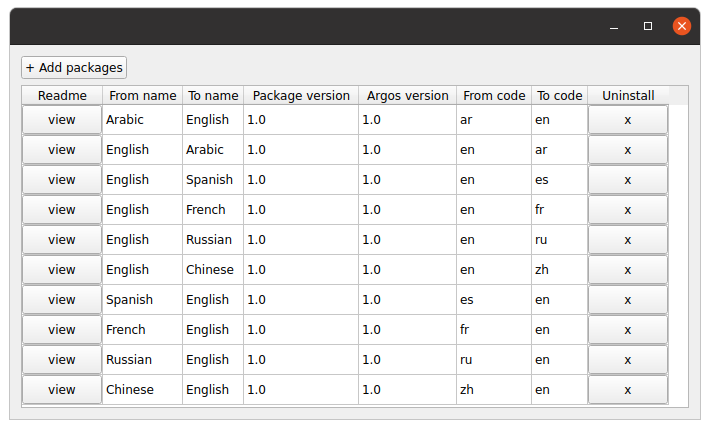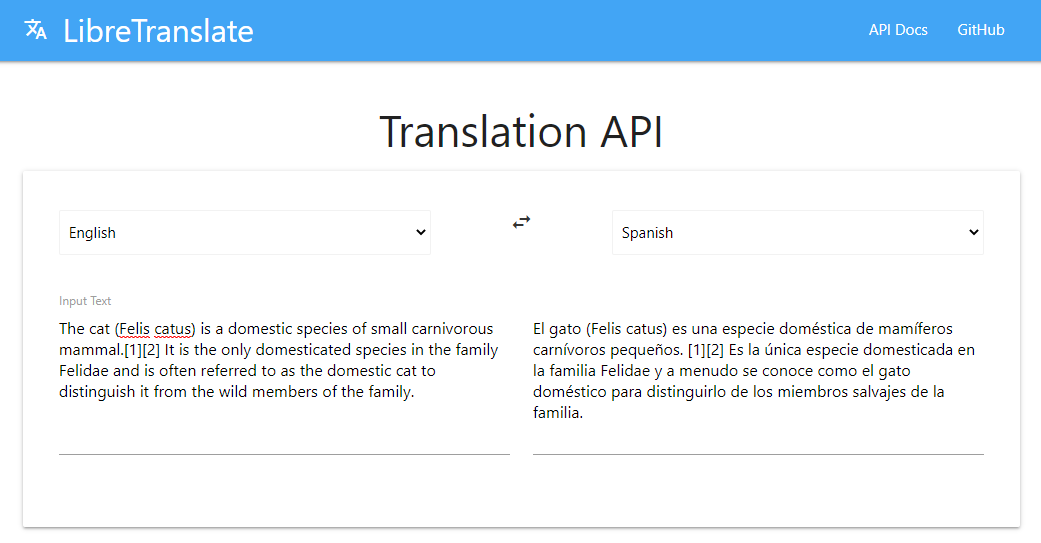Argos Translate
Open source offline translation app written in Python. Uses OpenNMT for translations, SentencePiece for tokenization, Stanza for sentence boundary detection, and PyQt for GUI. Designed to be used either as a GUI application or as a Python library.
Argos Translate supports installing model files which are a zip archive with an ".argosmodel" extension that contains an OpenNMT CTranslate model, a SentencePiece tokenization model, a Stanza tokenizer model for sentence boundary detection, and metadata about the model. Pretrained models can be downloaded here. To install a model click "Manage packages" from the toolbar in the GUI and select your model file. By default models are stored in ~/.argos-translate, this can be changed in settings.py or by setting the value of the $ARGOS_TRANSLATE_PACKAGES_DIR environment variable. When running from a snap package models can be pre-packaged with the snap package or installed after installation to $SNAP_USER_DATA.
Argos Translate also manages automatically pivoting through intermediate languages to translate between languages that don't have a direct translation between them installed. For example, if you have a es -> en and en -> fr translation installed you are able to translate from es -> fr as if you had that translation installed. This allows for translating between a wide variety of languages at the cost of some loss of translation quality.
Models
Models available for download here, and are being trained using this training script. Models are also available for torrent download in the /p2p directory.
Currently, there are models available to translate between:
- Arabic
- Chinese
- English
- French
- German
- Italian
- Portuguese
- Russian
- Spanish
Examples
GUI


Python
>>> from argostranslate import package, translate
>>> package.install_from_path('en_es.argosmodel')
>>> installed_languages = translate.load_installed_languages()
>>> [str(lang) for lang in installed_languages]
['English', 'Spanish']
>>> translation_en_es = installed_languages[0].get_translation(installed_languages[1])
>>> translation_en_es.translate("Hello World!")
'¡Hola Mundo!'
Command Line (Beta)
$ argos-translate-cli --from-lang en --to-lang es "Hello World"
Hola Mundo
LibreTranslate Web App (Demo)

LibreTranslate API
const res = await fetch("https://libretranslate.com/translate", {
method: "POST",
body: JSON.stringify({
q: "Hello!",
source: "en",
target: "es"
}),
headers: {
"Content-Type": "application/json"
});
console.log(await res.json());
{
"translatedText": "¡Hola!"
}
Installation
Install from PyPI
Argos Translate is available from PyPi and can be installed with pip.
python3 -m pip install --upgrade pip
python3 -m pip install argostranslate
Install from Snap Store
Argos Translate is available from the Snap Store and auto installs a content snap to support translation between Arabic, Chinese, English, French, Russian, and Spanish. Additional languages can be installed from supplementary content snaps.
With snapd installed:
sudo snap install argos-translate
Currently content snaps other than argos-translate-base-langs need to be manually connected but this hopefully won't be necessary in the future:
sudo snap connect argos-translate:argos-packages argos-translate-en-it:argos-packages
Python source installation
Dependencies
Requires Python3, pip (which should come with Python3), and optionally virtualenv to keep Argos Translate's dependencies separate from other Python programs you have installed.
Python Installation Instructions
On Ubuntu:
sudo apt-get update
sudo apt-get install -y python3
Install
- Download a copy of this repo (this requires either installing git or downloading a zip from GitHub):
git clone https://github.com/argosopentech/argos-translate.git
cd argos-translate
- Make a virtual environment to install into (optional):
python3 -m pip install --upgrade virtualenv # If virtualenv not already installed
virtualenv env
source env/bin/activate
- Install this package with pip:
python3 -m pip install --upgrade pip
python3 -m pip install .
Build and install snap package
- Install snapd if it isn't already installed.
- Using snapd install snapcraft and its dependency multipass:
sudo snap install multipass
sudo snap install snapcraft
- Clone this repo:
git clone https://github.com/argosopentech/argos-translate.git
cd argos-translate
- From the root directory of this project build the snap package:
SNAPCRAFT_BUILD_ENVIRONMENT_MEMORY=4G snapcraft
Any unzipped package files in package/ will be automatically included in the snap archive (and won't be able to be deleted by users of the snap).
Note, the build won't run with Snapcraft's default build memory of 2GB so you need to set the SNAPCRAFT_BUILD_ENVIRONMENT environment variable. More on Snapcraft forum.
- Install the snap package:
sudo snap install --devmode argos-translate_<version information>.snap
Run Argos Translate!
argos-translate
When installing with snap a .desktop file should also be installed which will make Argos Translate available from the desktop menu.





